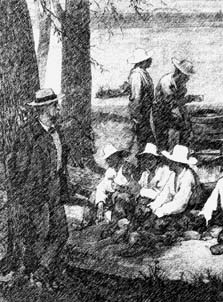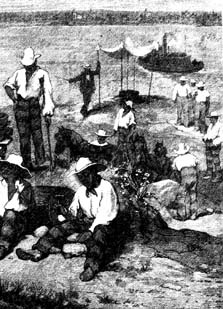The end of the nineteenth century and the dawn of the twentieth century were celebrated with a mood of optimism over society's progress, as typified by the tenor of the Association's report to the Legislature for 1900: "At the close of a brilliant and memorable century, marked by wonderful progress in science and by the extraordinary development in our national life, the [Association] congratulates all friends of humanity on the assured progress in the civilized world of the principles of prison reform."
Prison construction in the United States had advanced from the "dark, noisome dungeons which prevailed when John Howard began his remarkable work" in England during the eighteenth century to "[b]uildings that are thoroughly ventilated, lighted, heated and constructed on sanitary principles," while criminal codes in various states had begun to substitute "some degree of reformatory measures for those which are merely retaliatory."
The Association hailed the efforts to enact such reformatory laws as indeterminate sentences, parole, and probation; it was also an active advocate of professionalizing the function of prison wardens and overhauling the conditions in county jails.
|
Among the other purposes added to the mission statement since the Association's founding in 1844 were |
These themes would set the agenda for the Association's efforts in the early twentieth century, as the prison reform movement gained momentum, attained wider public support, and registered several major advances in implementing its legislative agenda.
Notwithstanding these successes, the cause of prison reform also suffered setbacks during this period, particularly in the areas of contract labor laws and the use of workhouses. . . .
The Association lamented that workhouses have "proved entirely inadequate" for the treatment of vagrants and drunkards, since there was "no scheme of training, no recognition of the fact of diseased will or morbid mental condition." . . .
Indeterminate Sentences, County Jails, and Labor Laws
New York was the leader in adopting indeterminate sentences; the first such statute was enacted in conjunction with the Elmira Reformatory laws. In 1900 the Legislature extended that practice to first offenders [and] at he Association's urging, . . . extended the probation and parole concepts of the Elmira Reformatory laws by enacting a series of probation and parole laws.
The probation law was based on the premise that if there remains a very large number whose reformation without imprisonment may be reasonably expected" and who should not bear the mark of a discharged prisoner. These might include "minor offenders ... persons whose offenses are the result of sudden impulses, some who have fallen into crime on account of circumstances, and many of those whose crimes are due to drunkenness."
Initially, the parole law applied only to sentences of five years or less, a situation that the Association said "forbids its
application to many who would be excellent subjects for conditional liberation."

A typical county jail.
|
The county jail system, which epitomized the almost feudal nature of the state's prisons, was a special object of scrutiny by the Association. The most flagrant abuse in the county jail system was the age-old practice known as the fee system, whereby the local sheriff derived an income from charging custody fees to the inmates in his care.
Prisoners were inevitably kept for longer periods of time because the sheriff benefited personally; in other instances "pressure [might be put on] a judge to sentence a man to jail where he may be a source of revenue to a friendly sheriff, instead of releasing him on probation."
The Association presented proof that in counties in which the fee system had been abolished the prison population had been reduced from 10 to 50 percent. The Association also recommended that the sixty-two different prison systems in the state should be centralized under a single statewide authority.
Finally, another controversial issue was the question of prison labor. Labor unions fought successfully to reduce dramatically the competition arising from cheap prison labor. The Yates Law, passed in 1888, abolished virtually all prison industries. It was abandoned the following year when the resulting idleness of prisoners led to huge discipline problems.
In its place the Fassett Law allowed prison industries so long as they did not employ enough workers to become a major competitive force in that category of goods. For example, prison industries in New York could not employ more than one hundred inmates in the manufacture of stoves, boots, or shoes.
Beginning in 1897, however, a constitutional amendment provided that prison industries based in New York could not compete at all against private companies, except in the sale of goods to state institutions. This became known as the state-use doctrine, which was soon adopted on a widespread basis throughout the United States.9
The Association disagreed vehemently with this policy, noting that "[the inscription of Pope Clement XI teaches the correct lesson: 'It is of little use to restrain criminals by punishment unless you reform them by education,' and I would add, teach them of honest and ennobling labor."
Fund-raising and Public Support
One measure of the Association's wider base of support in the early twentieth century can be seen in its fund-raising efforts. Still entirely dependent on voluntary contributions, in late 1909 the Association was the beneficiary of a $25,000 matching grant from Mr. Smith Ely, "a generous friend of the Association," to be used in establishing an endowment fund. A major fund-raising campaign was launched; when it ended in November 1910, the Association had raised nearly $55,000. Approximately 2,000 donors contributed to the Association that year, including almost 400 to the endowment fund.

Association headquarters
at 135 E. 15th St.
|
The Association's purpose in undertaking its first major capital campaign was to obtain funds to expand its programs beyond the narrow confines of New York City.
Among the areas targeted for expansion were programs to undertake "frequent and thorough inspections" of the penal institutions throughout the state, to develop employment opportunities for discharged prisoners, to extend "much-needed aid for prisoners' families and for discharged prisoners," and to develop a public relations program "regarding crime and its problems in this State."
A proposal for a quadrupling of the Association's annual budget -- to $75,000 -- was set forth, subject to the recognition that it might take a decade or more to implement all of those programs." Finally, the Association stressed the Legislature's responsibility to "lend a generous hand in subsidizing the state-wide parole work of the Association."
In 1910 the Association undertook an extensive renovation of its headquarters building, at 135 East Fifteenth Street, in Manhattan. . . . The first floor was set aside for the parole bureau, the library, and a waiting room for discharged prisoners, while the second floor housed the clerical staff.
|
In 1912 the state attorney general decided that private corporations could not serve as salaried parole agents for the state's reformatories, and the Association's parole bureau became part of the state's payroll. Its offices, however, remained in the Association's headquarters.
Seventy-first Annual Report -- 1915, p. 44.
|
The Association maintained a "comprehensive library of books and pamphlets on penological and criminological subjects, which is accessible to the public." Donations of books and reading materials were either added to the library collection or sent on to prisons in the state for inmates' benefit." By 1921 this endeavor had succeeded "in furnishing every county jail in the State of New York with a library of twenty-five or more approved books."
The fact that the Association was gaining wider public notice was no accident, as evidenced by the fact that by 1913 its mission statement had expanded to include "Publicity in prison reform" as one of the Association's purposes." This publicity effort . . . was carried out through a variety of avenues: a public relations office to deal with newspapers;" a public education program consisting of speeches and lectures to philanthropic, judicial, and religious groups; and a key membership role in national and international prison reform organizations.
The corresponding secretary of the Association was a tireless spokesman, giving speeches and lectures before groups such as Christ Church in Staten Island, the Church of the Ascension in New York, a sociology class at Yale University, and the People's Institute at Cooper Union.
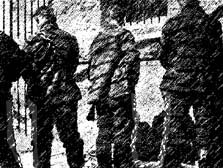
Chained Onondaga County Penitentiary inmates.
|
As part of this public education effort, starting in 1901 the Association's annual report included photographs of inmates, their cells, and prison facilities, both at old institutions and at new ones then under construction. Among the more startling photographs was a picture entitled "A Medieval Survival," showing "the survival of a medieval method of punishment at the Onondaga County Penitentiary" -- inmates shackled in chains, standing in place all day.
The abuses at Onondaga also included "pitch-dark and stifling dungeons ... for punishment purposes [and] chains, weighing about 20 pounds, were riveted to the leg of certain prisoners under punishment, to be worn at all times, and sometimes for months." The publication of that picture led to a formal investigation, the abolition of the chains, and the appointment of a new administration at the jail.
|
In 1870 the corresponding secretary of the Association, Dr. E. C. Wines, was a leader in forming these organizations; he received an appointment from President Grant to represent the United States in organizing the International Prison Congress.
|
The Association also had a noteworthy role with national and international prison reform groups. The Association was a founding member of the American Prison Association in 1870 and the International Prison Congress in 1872. In 1910 the Association assisted in hosting the first International Prison Congress held in the United States, leading seventy-five delegates from some twenty countries on tours of Elmira Reformatory and Auburn State Prison.
The U.S. Congress made a regular appropriation of $2,000 to support the International Prison Congress and to help pay clerical and traveling expenses of the American delegation. During that period the Association was active in forming various other national committees and associations to coordinate prison reform work; these organizations included the National Committee on Prison Labor and the National Prisoners' Aid Association.
The Association was instrumental in providing the impetus for the observance of an annual Prison Day in "hundreds of churches and synagogues throughout the state." Held on the last weekend of October for nearly fifty years, this public education program consisted of sermons on crime and the need for parishioners to enlist in prison volunteer work, followed by the distribution of literature describing the efforts of prison reform groups.
Known as Prison Sunday, the idea originated in February 1884 at a meeting called by the Association and attended by "over three hundred clergymen of all religious denominations from all parts of the State. The object of the meeting was the discussion of the relation between the Christian churches and the criminal." The circular sent to all churches in October 1884 called for churches to "give prayerful consideration to the duty of Christian people toward the criminal classes; both those who are in and those who are out of prison."
"Sing Sing Must Go"
. . . . The concerted effort to demolish Sing Sing Prison began in 1900, when it came to light that a large number of typhoid and tuberculosis cases were developing among the inmates. Within a two-month period forty-eight cases of typhoid fever had developed at Sing Sing Prison, and there were also "a large number of cases of tuberculosis." For several years thereafter, the Association presented reports by health experts on the dismal conditions at the prison.
In 1904 the Association's report included the observation that "[a] prison is perhaps the only place in the world where spitting regulations can be rigorously enforced [and] every prisoner must hold his hand before his mouth when coughing."
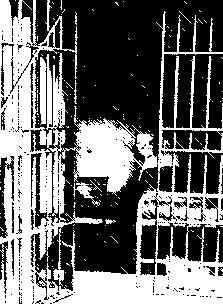
A Sing Sing cell did not have a toilets. It had a "night bucket."
|
This report also noted that "however great the crime he has committed may be, we have no right to sentence him to tuberculosis. But, leaving aside all altruistic considerations, for reasons of protection and self-preservation, it is our imperative duty to do everything in our power to isolate all tuberculous prisoners." In fact, from 1891 through 1902 approximately 50 percent of the deaths among inmates in New York prisons were from tuberculosis.
An investigative committee of the Association reported that the prison structure itself was largely to blame for this public health crisis. Its construction was begun in 1824 on low ground near the Hudson River, thereby ensuring perpetual dampness; its outer walls were two feet thick, with narrow slits for windows, thereby ensuring that sunlight "apparently has never entered the cells;" ventilation was nearly nonexistent in the cells; overcrowded conditions led to two and even three inmates sharing a space only 3 feet wide by 6 feet 9 inches long by 6 feet 6 inches high; and defective plumbing and open drainage were pervasive, leading the engineer to state that "a more unsanitary arrangement could hardly be devised."
The cells in Sing Sing did not have toilets. Instead, each cell was supplied with a "night bucket," which added to the stifling and contaminated air throughout the prison buildings and grounds. The Association urged the "immediate condemnation and demolition" of the prison, to be replaced with "an entirely new prison built on modern principles, in a more favorable locality."
|
At first, the new prison was slated for construction at Bear Mountain, "not far from West Point." That site was abandoned in 1910 when the land was incorporated into Harriman State Park. The next attempt, at Wingdale, near Pawling, had already advanced into the construction stage when a report showed that the site was "low and swampy." Finally, in 1912 a site was chosen at Beekman, in the Fishkill Valley, "beyond the New York City watershed," where 821 acres were acquired by the state.
Seventy-second Annual Report -- 1916, pp. 25-26.
|
The public outcry generated by the Association's report led to the establishment of the State Prison Improvement Commission in 1905. Its mandate was to study the structural and sanitary conditions at Sing Sing and Auburn prisons and the advisability of either modernizing those facilities or constructing new prisons. The commission concluded that modernization was not a practical or economic alternative; hence, it agreed with the Association that the old prisons should be abandoned and new prison facilities should be constructed on new sites.
Over the next ten years the issue slowly meandered its way through the bureaucracy, as new prison sites were chosen and abandoned. The Association battled to keep the issue alive, even undertaking an intensive public relations campaign to convince the Legislature to endorse the demolition of Sing Sing Prison, using the slogan "Sing Sing Must Go."
. . . Finally, in 1916 the Sage bill was passed, providing for the construction of a combined farm and industrial prison at a new location and a new short-term receiving prison at Sing Sing."
|
The bill was named for Henry M. Sage, a state senator and chairman of the Senate Finance Committee
|
. . . . Recognizing that any new facility would "be in service for probably fifty years," the Association held out for legislation that would foster the goal of prison construction compatible with the emerging trends in prison administration. The Association vigorously opposed perpetuating the conventional architecture of a "cellblock of bastille proportions and with interior cells."
In a "radical departure from traditional prison construction," the state's architect proposed that the new facilities be composed of moderately sized buildings (which would facilitate new classification schemes) and a number of alternate interior design plans that did not rely solely on inside cellblocks." Not until 1928 was the first of the new buildings at Sing Sing completed. After numerous delays and redesigns, however, the buildings that were finally constructed preserved in large measure the interior cellblock design that the Association had fought so hard to abolish.
|
The receiving and classification unit at Sing Sing Prison "is really a hospital psychiatric clinic.... If the State of New York is ever to make any headway in the scientific treatment of the inmates of its penal and correctional institutions, there must be a receiving and classification unit to determine the make?up of those who have offended against the laws of the State and also, so far as knowledge will permit, the kind of treatment they need."
Eighty-fourth Annual Report -- 1928, p. 39.
|
The primary concession in the new prison facility arising from the Association's efforts was the establishment of a reception clinic for the analysis and treatment of incoming inmates suffering from psychiatric problems.
Among the psychiatric categories under which prisoners were classified by the clinic at Sing Sing in 1928 were normal (26 percent), mentally defective (17 percent), psycho-neurotic (1.3 percent), insane (1.25 percent), as well as smaller percentages of inmates diagnosed as potentially psychotic, borderline defective, cerebrospinal syphilitic, epileptic, or senile.
The largest category, however, was psychopathic personalities, which included "the inadequate, the emotionally unstable, those with marked criminal tendencies, the alcoholic and the drug addict." This single category accounted for 44 percent of the 1,239 cases examined.
The battle to abolish Sing Sing Prison continued for many more decades. In fact, the original 1825 cellblocks at Sing Sing Prison were not finally abandoned or demolished until 1945. But the campaign initiated by the Association in 1900 to replace the original Sing Sing Prison presaged numerous other efforts to replace the state's antiquated and inhuman prisons with more modern facilities.
Thomas Mott Osborne and the Self-Government Movement
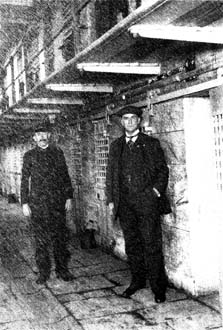
Thomas Mott Osborne on a regular visit to a typical Sing Sing cellblock (1915). Note the open drainage line at the lower left.
|
Even more dramatic than the battle to demolish Sing Sing Prison was the controversy over the proposed solution to crime and delinquency through inmate self-government. This movement was based on the theory that inmates could "learn the civic and social responsibilities of freedom only by having a relatively large degree of freedom within the prison."
It was grounded in the belief that even hardened criminals could be redeemed, and lead honest and productive lives once released, if they were treated properly by prison administrators.
These perspectives on prison reform were originated and popularized by Thomas Mott Osborne through his extraordinary tenure as a reformer both inside and outside the state prison system. He served as chairman of the State Commission on Prison Reform and, in late 1914, became the warden of Sing Sing Prison. He also served for many years as an officer of the Association.
Osborne's attitude toward inmates was truly revolutionary. Rather than fight the never-ending battle of disciplining incorrigible and disruptive inmates through harsh punishments, he sought to remove all unnecessary restrictions and punishments that caused "friction, resentment and loss of self-respect" -- including the rule of silence. His goal was to institute a system of self-government that would lead to "development in the inmates of self-respect, initiative and a sense of personal and social responsibility."
|
The story of the inception and development of this interesting experiment in prison administration has been vividly told by Mr. Osborne in his two books, "Within Prison Walls" (D. Appleton & Co., 1914) and "Society and Prisons" (Yale University Press, 1916).
A month after Osborne's voluntary incarceration, two women -- Miss Madeleine Z. Doty and Miss Elizabeth Watson -- were voluntarily incarcerated in the Auburn State Prison for Women for four days. Miss Doty also wrote a book about her experiences, entitled "Society Misfits" (The Century Company, 1916).
|
A year before his appointment to Sing Sing, Osborne had arranged to be incarcerated as an inmate in Auburn Prison for one week in October 1913. His eyewitness account confirmed the inmates' enthusiasm for the self-government program and exposed additional abuses, such as the absence of dinner on Sundays and the use of the "cooler," or dark cells, to discipline inmates. His account led to the correction of those practices and the publication of a book on his experiences.
Under the self-government system implemented by Osborne at Sing Sing, areas such as education, sanitation, food, and recreational activities were turned over to committees of inmates, and prison guards were even removed from the workshops. Discipline was decided upon by a panel of inmate judges. Under the old system, "there was never a time ... when inmates could not obtain 'dope' or whiskey [and] there was never a time when unnatural vice did not flourish to some extent.... Such abuses are practically beyond the control of the Warden unless he has the good-will and active cooperation of the inmate body in suppressing them." Osborne's system of self-government succeeded in enlisting inmates' support to expose these evils and to improve prison life and discipline on a broad scale.
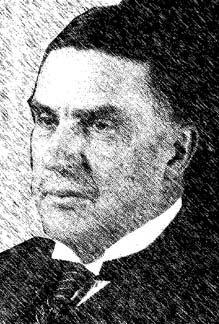
Thomas Mott Osborne.
|
The transformation of the prison from a hotbed of riots and disciplinary problems to an oasis of democratic tranquillity during Osborne's brief tenure at Sing Sing attracted considerable media attention. The intense public focus on Osborne's program helped lead to its demise. A "great influx of visitors to the prison," sometimes "several hundred in a single day," came to visit and observe this great experiment in social engineering, where for the first time many inmates learned civic responsibility and social service.
The enemies of Osborne's reforms -- the "prison aristocracy" of hardened criminals, the "old?line" guards, and ultimately the governor and the superintendent of prisons -- sought to scuttle his efforts. In a blatant political maneuver, Osborne was indicted by a grand jury on charges of perjury aud misconduct in office. Although ultimately acquitted, in October 1915 Osborne resigned as warden "under the conviction that [those state officials] were seeking to embarrass his work and destroy his influence."
|
These organizations were the Welfare League Association, founded in 1915, and the National Society of Penal Information, founded in 1921. Upon Osborne's death in 1931, the two organizations were merged to form the Osborne Association.
|
Osborne went on to found two new organizations, one dedicated to assisting discharged prisoners and the other serving as a research institute on prison conditions and reforms." His spirit and dedication live on through the Osborne Association, which today operates a series of direct service programs aimed at assisting former prisoners and their families to lead productive and crime-free lives, and [was] a sister organization to the Association.
Osborne's successor as warden of Sing Sing Prison sought to continue the program of inmate self-government as well as to improve medical care and sanitary conditions in the prison. But his greatest frustration came from the realization that "few of the inmates who were paroled or discharged had any idea what they would do to earn an honest living after they got out." Essentially, "they had come to prison without a vocation, trade, or calling, and they were going out in the same condition." . . .


